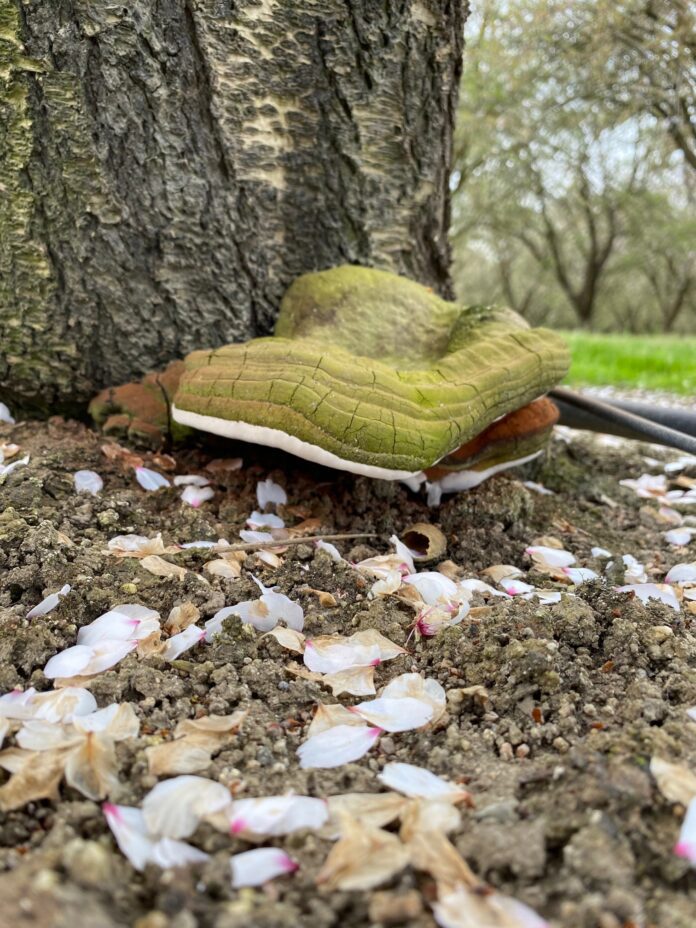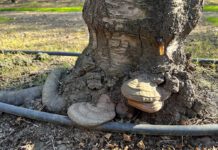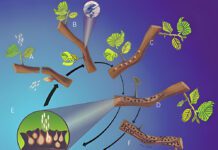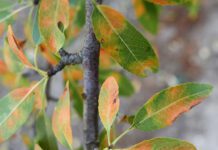A link between an aggressive wood decay fungus and crown gall in almond trees is being studied by a team of UCCE advisors. Almond orchards in Kings, Tulare, Kern and Madera counties have experienced tree loss due to Ganoderma adspersum where high incidence of crown gall was reported. Plant pathologists suspect that the crown gall, caused by the bacterium Agrobacterium tumefaciens, may predispose trees to the decay fungus.
Elizabeth Fichtner, UCCE plant pathologist and advisor in Tulare and Kings counties, said crown gall infections may be present years before a tree becomes infected with Ganoderma. The theory is crown gall creates an infection court (a technical term for the opening that allows the fungus an opportunity to infect the tree).
Almond growers in these San Joaquin Valley counties have been aware of this wood decay fungus since 2016. While there are four known species of Ganoderma in California, the G. adspersum species is most aggressive in young trees and appears more prevalent on Nemaguard rootstock. This disease spreads by spores in the air which are released by large conks growing at the base of the tree. The fungal disease can be present in the tree for as many as five years before signs of the conks appear. Meanwhile, the wood decay fungus goes undetected as it weakens the tree.
G. adspersum fungus destroys almond trees from the inside out by rotting the wood at the base of the tree. Other signs of infection are a less dense canopy, a later-than-normal bloom, shallow root systems and flat strips on the trunk.
Crown gall bacteria survive in gall tissue and in soil. This disease is most damaging in young trees. According to Almond Board of California (ABC), most peach-almond hybrid rootstocks are very susceptible to crown gall.
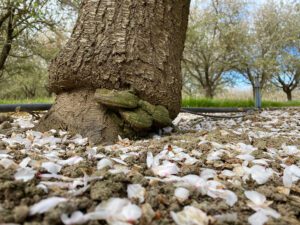
Crown Gall Bacteria Invades
Cliff Beumel with Agromillora California Nursery said crown gall is a very distinctive disease in almonds. As the scientific name implies, Agrobacterium tumefaciens produces tumors where bacteria have invaded the tissue through an opening caused by wounding or from natural causes like growth cracks. The soil around the gall or tumor contains a higher level of the bacteria, and any equipment or water moving from there can spread the disease. He said the bacterium does not move systemically to a very limited extent in an infected tree but can cause galls to appear in different locations once initially infected with crown gall.
Potted nursery trees are popular with growers who want to avoid early crown gall infections in a new orchard, Beumel said. These trees are grown in a substrate and do not have contact with soil until planted. When planting, care must be given to avoid any injury that can provide opening for disease. Beumel said fields are fumigated with methyl bromide to eliminate soil pathogens present before trees are planted.
Starting with clean soil is the first step in establishing an orchard, Beumel said. Research done by UC did show fumigation with methyl bromide killed much of the crown gall bacteria in the soil, but fumigation also eliminates many of the beneficial bacteria and fungi that can help suppress a population upswing of the crown gall pathogen if it is reintroduced to fumigated soil.
Reid Robinson at Sierra Gold Nurseries said anerobic soil disinfestation has been used in their bareroot nursery strategically, in limited locations, for the last five years or so. Before that, he said Sierra Gold had almost 10 years of research data from the state nematologist, performed at the nursery, showing that ASD is as effective as conventional fumigation for nematode and other pathogen suppression.
ABC reports Ganoderma outbreaks at harvest when shaking may create wounds below the soil line at the base of the trunk. Sweeping nuts in windrows spreads spores from conks through the air in an orchard. Postharvest irrigation and rain allow spores to filter into the soil.
Conk Growth Study Underway
Fichtner said it is unclear how long it takes for conks to develop on trees after infection. A study is underway to determine how fast the conks regrow after they are removed. She noted that of conks removed from trees in December, 10% regrew by March and 20% had regrown by April. The conks that regrew formed on new places on the tree and not in the location where the old conks were excised.
At the trial site, Fichtner said about one third of the trees have a documented history of conks, but believes this is an underestimation of the real level of disease incidence in the orchard because the trees may be infected before the conks (also called fruiting bodies) appear. She added there does not seem to be any pattern to the infections other than Ganoderma being more prevalent on trees that had crown gall.
Studies conducted at UC Davis suggest stem infections with crown gall do not alter a tree’s susceptibility to future infection with G. adspersum.
Fichtner, along with UCCE Farm Advisors Mohammad Yaghmour and Raymond Mireles, began their study of this disease interaction in February. More than 6,000 trees were surveyed across two orchards and rated for incidence of crown gall and Ganoderma. Both orchards are planted on Nemaguard rootstock and include Nonpariel, Monterey and Fritz varieties. Fichter noted in her Tulare County Programmatic News that results of the statistical analysis indicate a significant association between the two diseases on all varieties in both orchards. She said for each incidence of crown gall, the probability of infection with G. adspersum increased by more than 80 times across all varieties in both orchards.
As part of their research, Fichtner, Yaghmour and Mireles are also trying to determine if a phosphite treatment can help affected almond trees. Phosphite products induce plant defense responses to pathogens, preventing disease, not curing. In their study, they are testing the use of KPhite® 7LP, a Plant Food Company, Inc. product, for prevention of disease spread in orchards. This product is known to control other plant diseases such as Botryosphaeria and Phytophthora. Fichtner said it can be applied to trees as a foliar treatment or delivered with fertigation. In the trial, she said the foliar application is being done on the Nonpareil and fertigation on the Fritz and Monterey varieties when the trees are actively growing.
She said they will also be evaluating the response of phosphite treatments on the rate of fruiting body or conk regrowth and hope to identify control measures growers can take to mitigate the effects of these diseases.

Cecilia Parsons | Associate Editor
Cecilia Parsons has lived in the Central Valley community of Ducor since 1976, covering agriculture for numerous agricultural publications over the years. She has found and nurtured many wonderful and helpful contacts in the ag community, including the UCCE advisors, allowing for news coverage that focuses on the basics of food production.
She is always on the search for new ag topics that can help growers and processors in the San Joaquin Valley improve their bottom line.
In her free time, Cecilia rides her horse, Holly in ranch versatility shows and raises registered Shetland sheep which she exhibits at county and state fairs during the summer.







